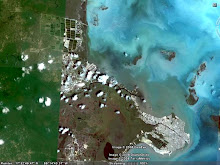I have also had a chance to tour some of the area farms and check out our progress. In addition to the work with Aqua Mats, other mitigations are also ongoing in the effluent canals.
One of those projects is mangrove planting. Mangroves are a kind of tree that grow in salt water. They remove nutrient directly from effluent water and support colonies of organisms that also absorb nutrients. Recently I had a chance to check on some of those we've been doing for the World Wildlife Fund (WWF).
Here's a picture at Aqua Mar shrimp farm showing Mauricio Mejia of WWF checking out some plantings we did with John Cheeseman of the University of Illinois. Survival is still over 95% at this site. We're happy with the progress here.

We also checked some plantings from Royal Maya. Some of these plantings were done in August of 2008. Some were done in November 2008. This picture shows Mauricio Mejia and Adrian Vernon (a community researcher in Placencia) checking out the November planting. The survival was very good there as well.
And the plantings from August at Royal Maya are growing to impressive sizes, with 4 internodes already in place and side-branching beginning. When these trees are fully grown, they will be an important part of the mitigation process in the farm effluent.






This sounds amazing. Do the mangroves require a lot of maintenance? And I noticed in the pictures that they're grown on land/the banks. How do they pull nutrients from the water?
ReplyDeleteThe mangroves don't require any maintenance just yet.
ReplyDeleteTheir roots extend far into the water in the sediment. Once they are mature, they will send out prop roots that will grow directly in the water and support a community of attached organisms.